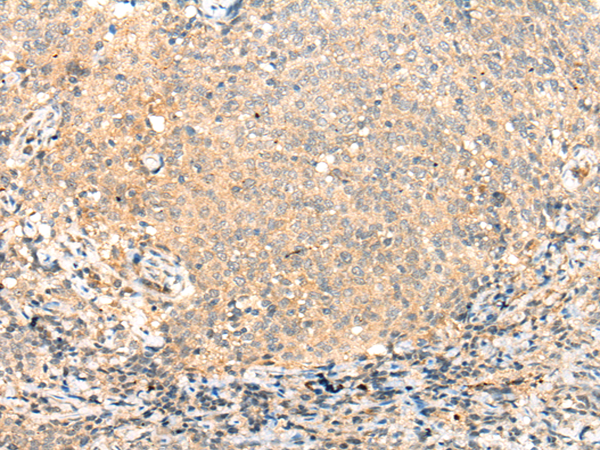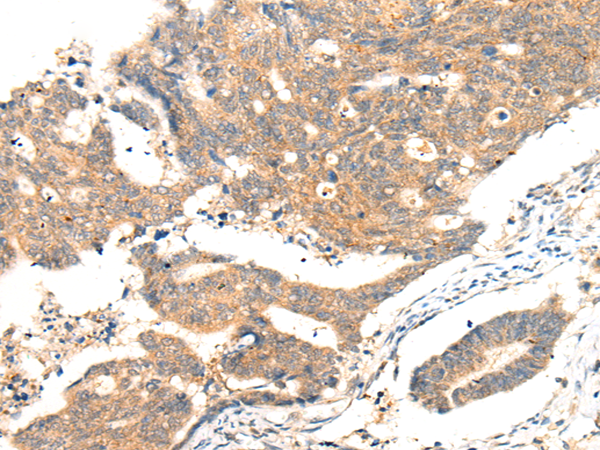

| WB | 咨询技术 | Human,Mouse,Rat |
| IF | 咨询技术 | Human,Mouse,Rat |
| IHC | 1/25-1/100 | Human,Mouse,Rat |
| ICC | 技术咨询 | Human,Mouse,Rat |
| FCM | 咨询技术 | Human,Mouse,Rat |
| Elisa | 1/2000-1/5000 | Human,Mouse,Rat |
| Aliases | VWFCP; C9orf8; vWF-CP; ADAM-TS13; ADAMTS-13 |
| Host/Isotype | Rabbit IgG |
| Antibody Type | Primary antibody |
| Storage | Store at 4°C short term. Aliquot and store at -20°C long term. Avoid freeze/thaw cycles. |
| Species Reactivity | Human |
| Immunogen | Synthetic peptide of human ADAMTS13 |
| Formulation | Purified antibody in PBS with 0.05% sodium azide and 50% glycerol. |
+ +
以下是关于ADAMTS13抗体的3篇参考文献,按文献名称、作者和摘要内容简要列举:
---
1. **文献名称**:*"Antibodies to ADAMTS13 in patients with thrombotic thrombocytopenic purpura"*
**作者**:Johanna A. Kremer Hovinga, Bernhard Lämmle
**摘要**:该研究探讨了获得性血栓性血小板减少性紫癜(TTP)患者中ADAMTS13抗体的临床意义,发现抗体的存在与疾病复发风险增加相关,并提出了抗体滴度与治疗反应的关系。
---
2. **文献名称**:*"ADAMTS13 autoantibodies in patients with thrombotic microangiopathies and other immunomediated diseases"*
**作者**:Flora Peyvandi, Marco Cattaneo
**摘要**:文章分析了不同免疫介导疾病(如系统性红斑狼疮、抗磷脂综合征)中ADAMTS13自身抗体的发生率,揭示了其在非TTP患者中的潜在病理作用及检测方法的临床价值。
---
3. **文献名称**:*"Structure of von Willebrand factor-cleaving protease (ADAMTS13) and its function in thrombotic thrombocytopenic purpura"*
**作者**:X. Long Zheng, J. Evan Sadler
**摘要**:该研究解析了ADAMTS13的结构与功能,阐明了抗体介导的酶活性抑制在获得性TTP中的核心机制,并讨论了针对抗体治疗的潜在策略。
---
如需更多文献,可进一步补充。
ADAMTS13 is a plasma metalloprotease primarily responsible for cleaving von Willebrand factor (VWF) multimers, regulating their size and preventing spontaneous platelet aggregation. Autoantibodies targeting ADAMTS13 are central to the pathogenesis of immune-mediated thrombotic thrombocytopenic purpura (iTTP), a rare, life-threatening thrombotic microangiopathy. These antibodies, typically IgG, neutralize ADAMTS13 activity or accelerate its clearance, leading to ultra-large VWF multimers that promote microvascular thrombosis.
Most anti-ADAMTS13 antibodies are inhibitory, directly blocking enzyme-substrate interaction or binding to critical domains like the spacer region. Non-inhibitory antibodies may enhance proteolytic degradation or disrupt secretion. Their development is linked to autoimmune dysregulation, though triggers remain unclear. Genetic factors (e.g., HLA-DRB1*11) and environmental stimuli (infections, pregnancy) may contribute.
Laboratory diagnosis relies on detecting severe ADAMTS13 deficiency (<10% activity) with anti-ADAMTS13 antibodies. Treatment involves plasma exchange, immunosuppression (rituximab, corticosteroids), and caplacizumab. Persistent antibodies correlate with relapse risk, necessitating monitoring. Research continues to map epitopes and develop targeted therapies. Understanding these antibodies enhances management of iTTP and related disorders.
×